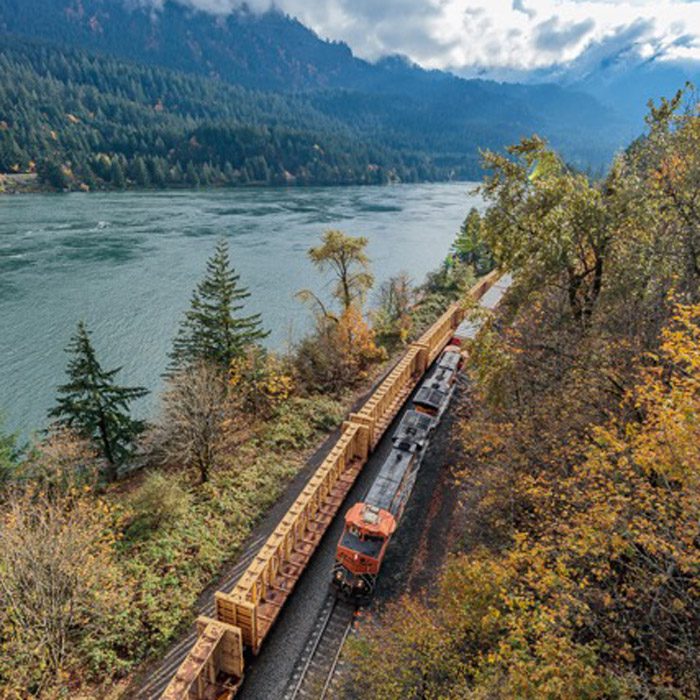John Lovenburg, Vice President — Environmental for BNSF, recently penned this guest column in the Olympian on our commitment to safety.
Rail industry works hard to improve safety
Rail transport is vital to Washington’s economy — $28.5 billion each year in positive economic impact, according to a recent study by the Washington Council on International Trade. This is crucial for a state where 40 percent of all jobs are tied to trade. Trains haul grain to our ports, aluminum and steel to our factories, plane fuselages and other parts to The Boeing Co., cement for our roads, and containers full of clothes, processed food, TVs, computers, furniture and many other products to consumers in Washington and across the nation.
We also haul hazardous materials, including chlorine that keeps our water supply safe, ammonia used to make fertilizer and crude oil that is refined in Washington to make gasoline for our vehicles and jet fuel for aircraft. We recognize the special significance that comes with hauling hazardous materials, and we take additional measures to ensure their safe transport. For us, nothing is more important than safely operating through the communities that we serve.
No mode of ground transport surpasses rail when it comes to safety, environmental performance and affordability. On average, railroads are four times more fuel-efficient than trucks, according to an independent study for the Federal Railroad Administration (FRA). Burlington Northern Santa Fe’s unrelenting focus on safety is reflected in our excellent safety program and record. We have invested billions of dollars each year to continuously improve our operations, infrastructure and safety efforts. The first line of defense is prevention — policies, training, technologies and preventative maintenance — to make sure accidents don’t happen.
We are continuously investing in new technologies and infrastructure to reduce risk. BNSF inspects its track more frequently than required by the FRA. Most crude oil routes on BNSF are inspected up to four times per week, more than twice the inspection frequency required by the FRA, and our busiest main lines can be inspected daily, which includes our route through the Columbia River Gorge. BNSF also has special detection technology along key routes on our network sending back thousands of messages daily as they monitor for early signs of potential problems that could cause premature equipment wear or failure. Detectors are placed even more closely together in places such as the Gorge to ensure potential issues are elevated as quickly as possible. BNSF has also been developing predictive analytics to leverage the combined information received from the multiple types of detectors to discover potential issues before they arise.
We also use a Locomotive Event Recorder that downloads information about a train’s speed, crossing grade signaling and braking. A computer program screens this data and alerts a supervisor if a locomotive operates outside defined parameters. Specially equipped vehicles are used to measure the track’s rail alignment, curvature, acceleration, and crosslevel of the two rails. BNSF recognizes that accidents can happen. That’s why we work closely with emergency responders in communities throughout our service area. BNSF has trained thousands of first responders and sponsored many to attend three-day specialized crude-by-rail trainings in Colorado and at Texas A&M. Together with local emergency response agencies, BNSF has developed response plans and staged specialized equipment and hazmat responders across the rail network.
We are committed to the safety of our communities and their first responders. Last year, we trained upward of 10,000 public emergency responders, with nearly 900 of these responders from Washington, on how to safely respond to hazmat incidents. BNSF has specialized equipment and hazmat responders staged across its network to deal with hazmat and crude oil incidents, including for firefighting and spill cleanup. During a hazardous materials incident, our BNSF responders will be responding in unison with public responders so that through our combined efforts the incident can be mitigated safely and effectively.
In Washington, we have resources and equipment staged in Everett, Seattle, Vancouver, Longview, Wishram (Columbia River Gorge), Pasco and Spokane. In Washington, BNSF has 32 hazmat technician level responders located in Everett, Pasco, Seattle, Spokane, Vancouver and Wenatchee.
New, advanced technologies are also improving coordination between BNSF and response agencies. Two new technologies — AskRail and Securetrak — provide immediate access to real-time data about individual rail cars, cargoes, and location information for first responders.
The AskRail mobile app, developed by the rail industry, provides first responders with car-specific data for hazmat contents and railroad contacts during an incident. BNSF’s Securetrak, which is a real-time, web-based Geographic Information System tracking program, is available to state and/or regional emergency centers.
Rail is the backbone of the Northwest. For well over a century, BNSF has safely moved goods to and from the Northwest and is proud of our strong ties to the region. Our commitment to preventing accidents contributed to the FRA declaring 2013, 2014, and 2015 the safest in U.S. history. This is a legacy we intend to maintain and enhance in the years to come.




